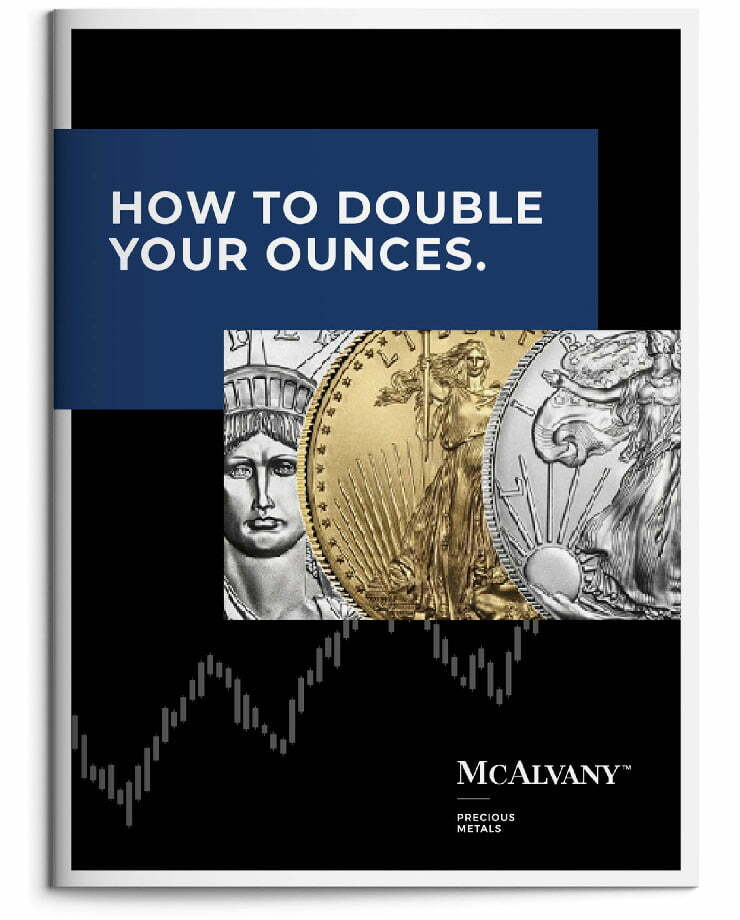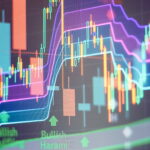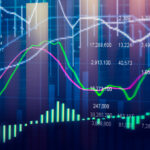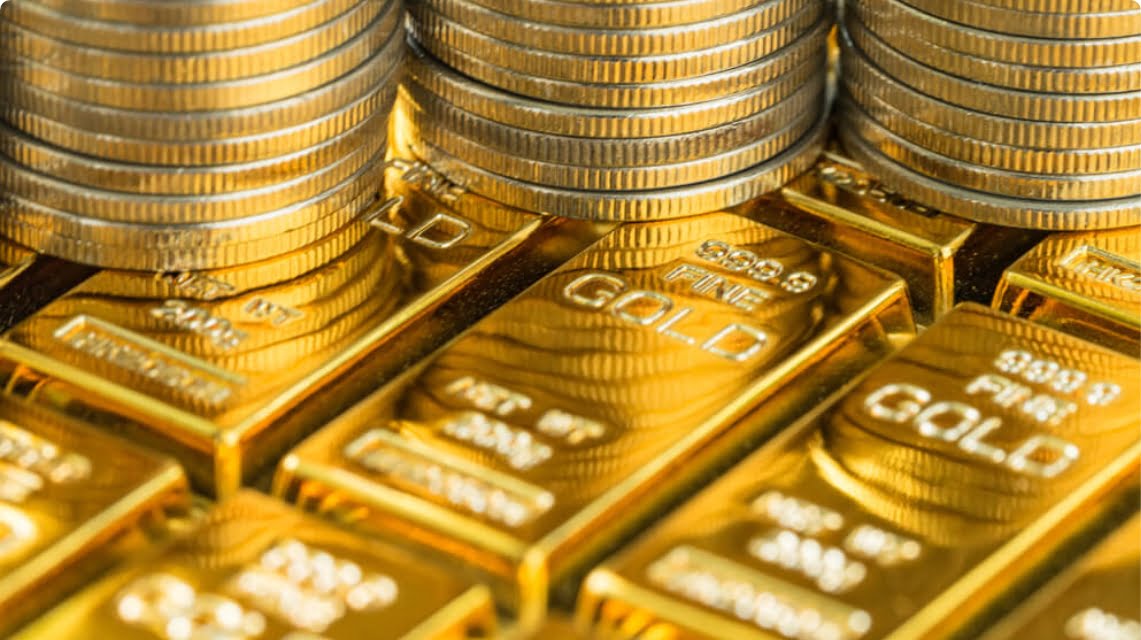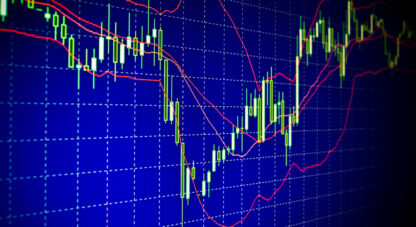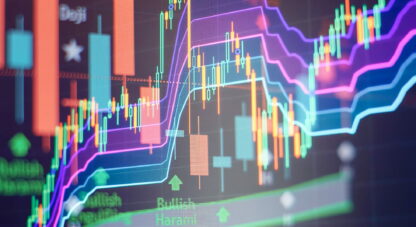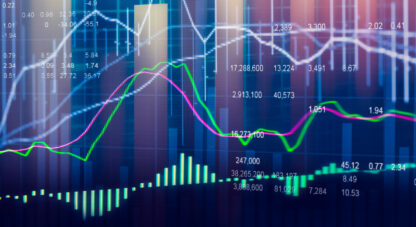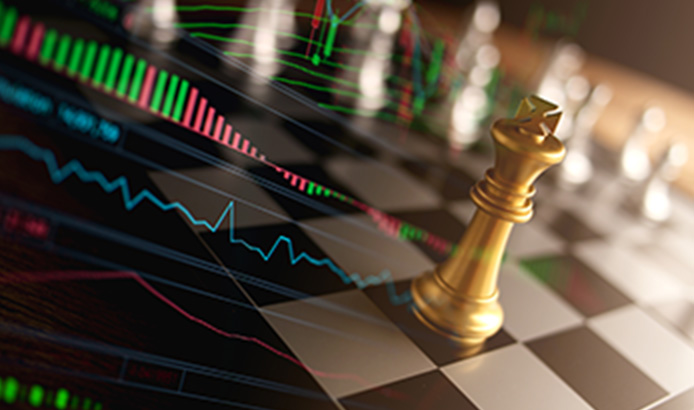Podcast: Play in new window
- Outflows Out Of U.S. Assets Going Into Gold
- Goldman Sachs Increases Gold Price Prediction
- China Increases Gold Imports On High
“So this is why I would say equities are a sideshow, the weakness in equities, the current compression across the indices. Relative to the bond market and currency market, that’s what it is. It’s a sideshow. The dollar’s year-to-date decline versus the euro is only 9.2%. The US Treasury market, if you’re looking at the 20-year Treasury, only lower by 2% year-to-date. These markets are actually where the real concern lies. And it’s not because it’s bigger numbers, but it’s because it’s a much bigger market.” —David McAlvany
* * *
Kevin: Welcome to The McAlvany Weekly Commentary. I’m Kevin Orrick, along with David McAlvany.
David each morning I walk outside and I look at the mountains, and I eat my oatmeal, just stand and think. And as I was doing that I started to think about what’s going on with the dollar right now, and the possibility of worldwide inflation, high inflation, I don’t want to say necessarily hyperinflation, but I was thinking what does it look like when the world’s reserve currency starts to melt down?
David: We’ve referenced Stephen Miran’s paper, which he wrote back in November of last year. I think we even put it in the show notes a number of weeks ago. And it’s important to see the game plan that is feeding the Trump administration’s idea of reindustrialization. Implicit to the paper is devaluation of the dollar. There’s no concern with that. It’s an objective which is clear. They’re comfortable with it, but it does have implications for overseas investors. It does have implications for US investors with dollar assets.
Kevin: The other day I was talking to my wife and I said gold topping $3,500 an ounce at one point here in the last few hours, that basically is saying what is going to happen to the prices of everything else. Gold is signaling something. Last night, Dave, when we sat and had our Talisker, it’s getting pretty expensive to sit and have our Talisker, it used to be more affordable. But I’m thinking that gold is signaling the increase of our Monday nights.
David: That’s right. That’s right.
Kevin: Yeah. So gold is signaling the increase in our Talisker on Monday nights. But the volatility right now, for so long we were falling asleep with the VIX, the volatility index, that’s not the case now.
David: No, and some would even ask: the equity volatility, is that important, is that something of a sideshow? And we would say, in fact it is a sideshow, but we’ll work towards that conclusion. Investors are in a volatility meat grinder again. They’ve got to contemplate the upside of risk assets, and perhaps they’re reconsidering what downside looks like as well. From one Truth Social post to the next, markets are subject to surprise after surprise after surprise. So what is a healthy correction? What is a full-blown bear market? And to what degree do tariff uncertainties shape the global investor’s motivation to own US assets, US denominated assets of any kind?
It’s this question: to stay or go? Double-digit declines in the largest stock indices are commonplace. It’s the Russell 2000, the Dow transports, NASDAQ, high-flying sectors like semiconductors, off 23%; the Mag-7 on an equal weighted basis, now off over 25% year to date. And of course, if you’re looking for a little bit more fun and entertainment, the five times Mag-7 ETF is off 89% year to date, 92% from its all-time highs in December of last year. So the gods of the marketplace give and take away. Leverage is a force multiplier, and there’s a lot of it spread across asset classes.
Kevin: You and I both ride mountain bikes. My son just rebuilt the shock on the rear part of the bike. When we lose our shock absorption, we really feel the bumps. And if you think about it, the Federal Reserve and just the policy up to this point has been like a shock absorber, you could get quite complacent. That’s probably why volatility didn’t really matter until now.
David: VIX is one of those measures, the expected volatility measured in the options market. It has moved back to levels typical of a bear market, far away from the complacency range in the low teens. We saw that early in July last year, 12-1/2. Early in December, again 12-1/2, and even as recently as mid-February, 14 on the VIX. So from a valuation perspective, just another metric: the S&P 500 still trades at a price/earnings multiple of 22. With the Schiller PE coming off its recent highs, nearly 38 to still-expensive 32, what now is the trajectory for earnings in 2025?
When you think about the price/earnings multiple, you’ve got the price of the stocks and then you’ve got the earnings of the companies. And this metric could rise considerably with a series of earnings revisions or disappointments. In fact, the Citibank earnings revision index just had its worst week of negative corporate earnings revisions. And that logs 17 weeks straight of downgraded expectations. Frankly, it feels a little bit like the year 2000, when prices remained elevated even as earnings moved lower, and we had the PE ratio spike as a result.
Kevin: I know you watched the Buffett ratio as well, it got up over 200 for a while.
David: And that is moving in the right direction, on its way back to earth from a peak of over 200%. It’s now 176%. Again, that’s market cap of all publicly traded equities compared to GDP. And now it’s only 27.5% higher than the dot.com bubble.
Kevin: So what are we supposed to be looking at? What is the real show here? When you go to Ringling Brothers, there’s three rings going on at the same time. Is this just a sideshow?
David: Well, again, I come back to the Buffett ratio. It’s higher than the previous peak by 27.5%—still elevated, still well above the year 2000 peaks. GDP has to either jump considerably to bring that ratio down or prices have a lot farther to fall, and it’s obviously anyone’s guess. What’s yours?
Kevin: Well, I think it’s easier to guess in the United States where you are basically captive here, but what if you were a foreign investor, Dave, right now with the dollar falling and the equity and bond markets falling all at the same time.
David: So this is why I would say equities are a sideshow. The weakness in equities, the current compression across the indices—relative to the bond market and currency market, that’s what it is, it’s a sideshow. The dollar’s year to date decline versus the euro is only 9.2%. The US Treasury market, if you’re looking at the 20-year Treasury, only lower by 2% year to date. These markets are actually where the real concern lies. And it’s not because it’s bigger numbers, but it’s because it’s a much bigger market.
Kevin: So let’s just think this through though. Let’s say you’ve been making an income stream of 4% on bonds. If you’re a foreigner and you’ve lost 9%, there’s a pretty large net loss there.
David: You’ve got to think about the dollar and the role that it plays. It underpins the global system of finance. And so US dollar stability and the US bond market are really critical. As goes the availability of credit within the US markets, so goes the credit conditions of the globe. So as goes US dollar stability, so goes the appetite for US-denominated assets of all kinds. And surprising to many as the US equity market has come under pressure, the predictable flows from risky equity positions have not flown, as per usual, to bonds.
Kevin: Okay, so this goes back to that 4% income stream. If you’re losing, or if the dollar loses 9% of its value, why would you buy dollars if you were a foreigner?
David: That’s the point. A 4% income stream pales in comparison to a 9% currency decline. And perhaps it comes as no surprise that the global appetite for gold has been heating up. So while the euro is a relative winner over the last few months, the question globally is becoming increasingly one of denomination.
Again, no surprise that the global appetite for gold has been heating up. But more than a return on capital, global investors see the Trump administration’s forays into fisticuffs as a reminder of how important return of capital is. Return on capital can be a fixation, return of capital is now in focus.
Risk-off dynamics are driving gold demand in a host of geographies. China stands out, seen through institutional and retail demand. The People’s Bank of China has had to increase its import quotas to accommodate the increase in demand. John Reed of the World Gold Council noted in the last week that Chinese Gold ETF demand had inflows in the first 11 days of April greater than all of 2025 to that point.
And it’s similar here in the US. The US ETF inflows have picked up as well, 6.62 million ounces in net purchases year to date. Really it’s anywhere there’s uncertainty, there you’ll find an increase in demand for the most precious metal.
Kevin: And Powell’s tenure at the Fed looks tenuous.
David: This week it’s that uncertainty of Powell’s tenure at the Fed and what that portends for the dollar, what that portends for dollar assets—as if trade tensions were not already enough.
Kevin: So we may be talking about just a small snowball, but a snowball gets bigger and bigger as you start to look at the leverage that’s built on the dollar right now in the credit markets.
David: And in recent weeks, pressure has been building in the credit markets. You’ve got leverage loans and the liquidity that is needed for private equity groups to finance and to refinance. Those funds—that credit—remains scarce. Interest rates on high-yield debt—the old junk bonds so critical for buyouts—those rates are rising and becoming harder to get. Rarely does a day go by when credit doesn’t flow. And so when a week or 10 days or two weeks go by and there’s no deals, worries begin to surface.
Kevin: Well, the shock absorption seems to have been removed. So the commitment to just stabilize these markets at this point, it’s very uncertain. You know, Dave, we talk about the carry trade involving Japan, but there’s another trade that we’re hearing a lot about right now. It’s called the basis trade. What’s the difference?
David: The carry trade is where you can borrow at cheap rates and go invest that capital and receive higher rates, and you capture the carry, you capture the in-between return. And so that is one version of a carry trade. You’ve got another form of arbitrage, the basis trade, which is an arbitrage between Treasury futures contracts and the Treasury cash instruments used for delivery on those contracts—also a source of strain in the bond market today. Not because the arbitrage is shaky, but when you layer in 20:1 leverage up to 100:1 leverage, minor moves have major impact. And not all changes in the bond market are working as anticipated. You’ve got higher rates, you’ve got the dollar lower, and you’ve got leverage players going white-knuckle from one moment to the next. And this is back to the predictability of policies.
Without the usual predictability from policy makers, or the usual favored status that the dollar and Treasuries are afforded by global investors, their stress is building. Pressure and anxiety build, and it dissipates, then it builds again. And what has many global investors concerned is the degree to which the Fed can be relied upon to make sure the wheels don’t come off.
Kevin: Well, you talked about stresses where they come and they go. I think about a bow. When you pull a bow back, you can only pull it so far back. I remember when I was a kid, I had a handmade wooden bow, and I broke it. I pulled it back too far and it broke. Every morning when I wake up and gold is only going up, with virtually no corrections at all, there’s got to be a correction at some point, right?
David: Rubber bands stretch and then they contract again, quite typical of markets reaching extremes. There’s a reversal. How far these reversals carry will be watched by traders. So far you have a rally in equities. And the rallies we’ve seen in the last month, six weeks, they’ve been weak. And they’ve provided the liquidity for investors seeking to lighten their exposure. So you’ve had big sellers come in and feed those recoveries.
Gold, will we see it at lower levels? How low? The dollar, will it bounce? How high? And again, investors and traders will watch the extent to which these rallies take place. Will we have relief in interest rates? To what degree? Is it enough to unleash animal spirits, or do these relief rallies provide the over-leveraged speculator the opportunity to reverse speculative trades and hit the exits?
Kevin: So other than gold, what markets are you watching right now?
David: Again, we talk about equities as the sideshow. The markets to watch are credit and currency. These offer better indications of systemic stress, while equities are more of a barometer of investor enthusiasms. In a short-term you can also see the excesses of pessimism within the equity markets. When credit flows decrease—and that’s typically accompanied by the cost of credit rising, interest rates rising—you go from liquidity conditions being favorable to switching and becoming unfavorable. In fact, they can go one step further to on occasion being unsurvivable. That is the liquidity-to-solvency dynamic.
Kevin: So you and I started this podcast in 2008. We started doing it, and that was the global financial crisis. It was a good year to do it because it had not completely developed by then. But Dave, the dollar’s been in an uptrend every year of this podcast. We’ve had 17 years of rising value in the dollar.
David: And the reason why you have to focus so much on credit is because of that liquidity-to-solvency dynamic. If you recall, during the global financial crisis you had the executives at a number of banks who had no issues with solvency on a Monday. They were dealing with liquidity issues on Tuesday and Wednesday, and they were gone by Friday.
Kevin: They were packing their brown boxes and packing their desks.
David: So within just a few days liquidity issues can move towards solvency issues and bankruptcy. So the US dollar today trading at a three-year low—it has this week, and it’s ripe for a rally. And just like gold, which is incredibly over-bought, it’s ripe for a short-term correction, but the long-term trends of both assets are important to grasp. We are near a break point in the dollar, a break of a 17-year uptrend off of the 2008 lows, and there is a possibility of returning to those levels, which would translate into an additional 28.5% devaluation.
Kevin: That’s amazing.
David: So Stephen Miran apparently relishes the idea, and the White House will argue that trade competitiveness in our exports is going to be on a moonshot. But asset holders, and dollar asset holders in particular, will have a very different calculus. Let’s do a little mental gymnastics. Take the Liz Ann Sonders observation. She’s the CEO at Charles Schwab. Her observation that we may be seeing the early stages of a tectonic shift in global investment flows, leading to a more dramatic decline in demand for US assets from abroad.
Kevin: So let’s just repeat that. A dramatic decline in demand for US assets from abroad.
David: Place that into the same frame as the dollar breaking support and moving back towards 2008 levels. Just assume a three-year dollar downtrend through 2028 to arrive at those support levels, 70 on the euro index. That would be an average decline of 9.5% per year. Are there, are there sectors in the US economy geared for growth which could translate into a positive real return on investment after accounting for currency exchange losses?
Kevin: What would you need? You’re talking almost 10%, right?
David: So a return on investment of 9.5% in that scenario gets you to break even. So again, if you’re looking at Liz Ann Sonders’ comment, this is a significant hurdle to even be talking about. Wait, why did we take risk? So dollar stability, dollar strength, it invites overseas investment flows, and the opposite is also true. So I don’t have a crystal ball. Knowing the extent of currency compression and knowing the time frames, that’s all guesswork. This is just hypothetical—again, mental gymnastics. But when I say it’s critical to watch the currency in credit markets, it really is super important. And that’s where I think you begin to see the real shift in dynamics.
Kevin: So what you’re saying is the dollar at ’98, you need a rally at this point.
David: Or the die is cast for international capital taking flight and returning home. There’s a somewhat self-fulfilling dynamic once a trend is in place: selling begets selling, and as the dollar comes under more pressure, the liquidation trend becomes a secular trend, a multi-year trend. You can say, “Okay, well, this is the opposite of what we’ve seen before.” Appetite for Treasuries alongside growth assets, that happens when you have a stable currency, or when you have a currency which is increasing in value. Now we have a different setup. If we have not already sufficiently offended our creditors, financing a budget deficit of one to $2 trillion a year would in that scenario move to the category of miraculous, or more to the point it might be malicious, as the Treasury and Fed are forced to monetize debt.
Kevin: And so let’s take politics out of this for a moment, because this last week we’ve heard that Powell is playing politics. He doesn’t want to lower the interest rates, and obviously Trump wants him to. But could he just be looking at the dollar at 98, or 99 right now and the possibility of 98, could he be trying to protect the currency?
David: Well, and I think it’s fair to say that he doesn’t know the damage yet to be felt by these tariff regimes. So I think it’s true that higher rates are often an inspiration for stronger dollars. Higher rates attract investment. When we observe higher rates not accompanied by a stronger currency—and this is a critical distinction. So again, normally you see both of those happen at the same time. Higher rates, stronger dollar. When you have higher rates not accompanied by a stronger currency, something very important is happening. And I think that’s what the bond market is weighing, that’s what they’re trying to figure out.
Kevin: So Dave, the old model that I was taught was when equities get weak the money flows into bonds. That’s not working right now.
David: And these are subtle signs that traders pay attention to because it does suggest that something else is afoot. Equities have been weak. Bonds should benefit from a rotation to fixed income, and rates should as a consequence come down. The fact that equity weakness has instead been accompanied by bond weakness—higher rates—and coincides with currency weakness, that’s unnerving. And thus we have the Sonders observation, are these the early stages of a tectonic shift?
Kevin: I remember back in the 1990s we had our clients in a managed bond fund that had European bonds in it, and this is before the euro. So we had Deutschmarks in there, we had Italian bonds. I remember talking to the manager of that fund and he said, “The Italians, it’s really interesting to buy an Italian bond, you need to have dinner with the family, a spaghetti dinner. You buy the bond, and when it comes time to sell the bond, it’s the same thing.” It’s an off-the-books kind of market, you can’t watch it that much. And what we’ve been talking about today, Dave, are the public markets. It’s stuff that you can get the Wall Street Journal and actually say, “Okay, this is happening.” But isn’t there a gigantic credit market that’s a little bit like the spaghetti dinner credit market that’s private?
David: That’s right, and it’s just not as easy to wrap your mind around. We’ve been talking about the public markets—credit, equity, currencies, gold. Grant’s Interest Rate Observer notes that over the course of the cycle, credit risk has accumulated outside the public markets.
Most buyouts opt for loan-only structures, which come in two varieties: so-called leveraged loans and the private equity kind. Private credit is where the riskiest borrowers turn for accommodation. And what he’s getting at, and the critique is that private equity and private credit have allowed for a lot of what has become known as shadow banking. It’s no longer something that you can have the FDIC keep a measure on. You’re not looking at ratios, and you don’t have the ability to monitor risk.
Kevin: It’s not regulated, right?
David: No, it’s not. And so in that sense, we have something growing. It’s a risk within the financial markets which is largely underappreciated. Marty Friedson is quoted in Interest Rate Observer saying “it does suggest that there’s a backlog of defaults out there that haven’t happened yet, and will increase the default rate when we hit a recession.”
Finally, in that Grant’s article is a great piece. He highlights a comment that this could be like the savings and loan crisis, where everything was liquidated. You have these private funds, people don’t know what is actually in their portfolios—just like how the savings and loan associations were buying all kinds of real estate and high yield bonds. They didn’t have to mark their books to market, either.
Kevin: Dave, yesterday when we were meeting you were 20 minutes late because you had had a very interesting talk with a man who’s been in the markets and made really, really good decisions. He’s a banker, isn’t he? And he’s made some good decisions in the past, and built quite a legacy of being the maverick, doing the opposite of what the market is showing at the time.
David: Part of a team that tends to think about risk in a unique way. And a banker that is today raising all kinds of liquidity. He made a vast fortune buying distressed assets during the savings and loan crisis. And if you look at the portfolio, it’s fascinating because you can tell that whether it was the energy crisis or a crisis in timber or a crisis in residential real estate, they’ve bought when no one else was going to buy. They had liquidity when no one else had liquidity.
I think that’s one of the values of gold is it helps you maintain liquidity, and in fact you can see a bump in price as liquidity is diminished. You have the ability to take those funds and deploy them without having to choose a currency to rest in.
Kevin: So there’s a time to turn gold into acreage. There’s a time to turn gold into timberland, or maybe even commercial real estate at the right time.
David: So reloading the bank’s portfolio with cash, it’s because opportunities are coming down the road. We had an extensive conversation, and it was absolutely fascinating to see the mind of a market operator—not in the public markets, but when things come under pressure there’s a way to play it. And keeping the options open with higher liquidity, a gold portfolio as a part of that, it allows for navigating some challenging periods where, again, assets have not been marked to market. Ultimately, when they come to market, what do they sell for? It’s not going to be what you thought, it might actually be 50 cents on the dollar, 30 cents on the dollar. And actually we’ve got another client who’s deceased in the last five years, who was a CPA, and he was on the loan committee for a bank. And in a very similar way, was able to look through and handpick some unique opportunities, and quality assets selling for pennies on the dollar.
It’s not something that we have much of an imagination for when we think about the Dow trading at roughly 40,000, 39,000. We can’t imagine that publicly traded assets would ever trade for—at least in Dow terms—20,000, 15,000, 10,000. And yet the cycle, the way these things play out, and one of the reasons why I love the Dow/gold ratio so much, is it gives you an indication of when gold is too expensive relative to shares. Now that ratio can shift through a variety of ways. You can have the numerator or the denominator shift, and they can move in tandem with each other, just to lesser degrees, or they can move in opposite directions.
Kevin: Well, and if you think about it, the last 25 years we’ve seen gold—well, the Dow/gold ratio—go from about 42 ounces of gold at the peak of the Dow in 2000, down to, where are we at now? 12?
David: We’re at 12:1. During the global financial crisis it got as low as 6:1, and I think we will see 3:1 on the ratio. We’ve seen lower, but it remains to be seen the degree to which our central bank and others will intervene in the markets.
Kevin: One of the things I’ve noticed, Dave, is Goldman Sachs is in the business of not having people in gold. They would rather have people investing in the markets. But Goldman Sachs has basically had to look at gold and say, all right, well, 3,500 is not out of the question. Well, they hit that level, but they’ve now amended their predictions.
David: Their price estimates for this year are to finish the year around 3,700. And by the middle of next year to be right around 4,000 an ounce, that’s mid-year 2026.
Kevin: And that’s Goldman Sachs.
David: The justification is looking at geopolitics, looking at trade relationships, looking at the dollar, looking at how trade dollars are being recycled, looking at demand for Treasuries—or lack thereof. And through a complicated mix of factors coming up with the conclusion that, yes, we have investors just now coming into the gold market, following on the tails of central banks. This is an interesting and secular trend.
Kevin: Morgan just spoke at our meeting and he said, “Look, outflows out of the United States dollar or those assets implies inflows into gold.” And he basically said, right now, the playbook, the old playbook for gold is being played out with the Fed, they may try to toe the line, but they’re basically saying that they’d rather have inflation than a recession.
David: The US has been the best destination for growth assets for many decades, and it’s the place you come for opportunity. It’s also the place where you can assume a certain degree of stability within the currency. And so when you begin to see those variables shift, and you begin to see an increase in outflows, it is an indication of destabilization of something that was assumed to be just rock solid. The US dollar has been, in the global system, rock solid.
Kevin: Is that why Liz Ann Sonders called it a tectonic shift?
David: And why the implications for gold are very intriguing because you’re talking about a period of uncertainty that really the world has not seen in a long, long time. So as an expression of uncertainty, gold continues to perform well. Maybe that shouldn’t come as a surprise.
* * *
You’ve been listening to The McAlvany Weekly Commentary. I’m Kevin Orrick, along with David McAlvany. You can find us at McAlvany.com and you can call us at 800-525-9556.
This has been The McAlvany Weekly Commentary. The views expressed should not be considered to be a solicitation or a recommendation for your investment portfolio. You should consult a professional financial advisor to assess your suitability for risk and investment. Join us again next week for a new edition of The McAlvany Weekly Commentary.
